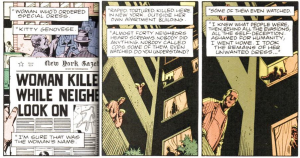Genovese Syndrome
Genovese Syndrome, or properly known as the Bystander Effect, is a social phenomenon that refers to the situation in which a group of people do not help a victim in the event of an emergency. The more people who witness the event, the less of a chance that the people watching the event will intervene. The mere fact that other people are around will affect the way an individual interacts with the person who is in need of help. The term "Genovese Syndrome" comes from the very public murder of Catherine Susan Genovese in New York in 1964, which sparked the first study of this phenomenon.
One explanation for the Bystander Effect is that having more people present heightens the chance that a person not notice the emergency [1]. People witnessing the emergency may believe that their assistance is not needed or think that someone else will help instead. This is a phenomenon known as diffusion of responsibility. Because of this mindset, individuals will influence each other to produce the same reactions, thus resulting in the entire group of people to not follow what they would normally do as a result of their own morals.
Contents
History
The murder of Catherine Susan "Kitty" Genovese was the case that resulted in the discovery of the Bystander Effect. Genovese, was stabbed to death in Queens, New York on March 13, 1964. While getting stabbed in the back by her assailant, Genovese screamed for help twice. Although her screams were heard by several neighbors nearby, they all ignored her cry for help. Half an hour later, the same assailant returned to stab and rape Kitty again. At the time, it was reported that 38 people were close enough to observe and/or hear the event occurring. After the police investigated, only two people were aware that the attack actually happened. This story was the catalyst for the research to show and explain the Bystander Effect. More recent data has shown that the number in this story is somewhat overblown, that in the end, only about a dozen people were around during the attack[2].
Notorious Cases
Throughout history, there have been countless incidents of the bystander effect where heinous acts could have been prevented but due to this psychological phenomenon, no individuals offered to help. Notable examples are listed below [3].
- Kitty Genovese
- Shanda Sharer
- Ilan Halimi
- Axel Casian
- Raymond Zack
Research and Possible Causes
The bystander effect was first studied by John Darley and Bibb Latané in 1968 in response to Kitty's murder. In their experiments, Darley and Latané would stage an emergency situation, then measure the time it takes participants to react, as well as examine their willingness to assist the person in need. The evidence overwhelmingly suggested that more bystanders leads to a slower reaction. [4]
There are currently several theories as to the origin of this effect. The most popular idea is that humans look to other people to verify how a situation actually progressing. Humans use each other's reactions as a clue to tell how to react appropriately to a certain situation. As the number of present people increase, it becomes easier for people to put off the responsibility to another person. If only one person sees an emergency, he or she may feel guilty for not helping a person out, leading to a faster responsive action. However if many people are around, that person can believe that other people will help and therefore he or she will not need to help. Because of the diffusion of individual responsibility, he or she does not experience guilt for not helping.
Genovese Syndrome in an Online Environment
There has been considerable controversy over whether the internet is allowing people to lead immoral lives online. The ability for users to be anonymous is one of the reasons that online users feel that they are able to act immorally on the internet on a regular basis [5]. Anonymity decreases the level of accountability of an individual's actions. Since the Bystander Effect is partially based on a person seeing how others are reacting, it is difficult to replicate this in a virtual world. However, the inability to replicate situations like Genovese's murder in the online environment does not mean that elements of the Bystander Effect are not present. Witnessing an event online may compel people to react in a manner more true to their moral values, thus lessening the Bystander Effect. Yet, at the same time the anonymity and distance afforded in online environments may strengthen the feeling that others will act, so no action is necessary. [6]
The bystander effect has been studied in online environments with regards to cyberbullying. Due to the distance afforded by internet interactions, people may feel more comfortable speaking out. However, the anonymity and ease of access that is often present in online environments also makes it easier for individuals to perpetuate and foster cyberbullying. Mechanisms such as aggregated likes, favorites, and retweets are a way for individuals to passively contribute to online harassment. Individuals who don't agree with this content may not like or favorite it, but they are still passively contributing to it by consuming it. Addressing these concerns with social media giants like Facebook and Twitter raises additional concerns about freedom of speech and censorship and dictating behavior in an online environment to prevent damaging bystander behavior also necessitates a conversation regarding free speech.
References
- ↑ "Bystander Effect", Psychology Today, 2018 [1]
- ↑ "Kitty Genovese murder: the real story of the woman who killed 'in front of 38 witnesses' in Queens in 1964", Stephanie Merry, 4 July 2016 [2]
- ↑ "Notable Examples", Wikipedia, 2018 Bystander Effect
- ↑ "Bystander Intervention in Emergencies: Diffusion of Responsibility", John M. Darley and Bibb Latane, 1968 [3]
- ↑ Pornari CD, Wood J. Peer and cyber aggression in secondary school students: the role of moral disengagement, hostile attribution bias, and outcome expectancies. Aggressive Behavior 2010; 36:81–94. Crossref, Medline, Google Scholar
- ↑ "The Bystander Effect: A Lens for Understanding Patterns of Participation", Harvard Business School [4]

